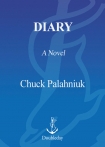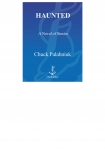Diary, Chuck Palahniuk [spicy books to read .TXT] 📗

- Author: Chuck Palahniuk
Book online «Diary, Chuck Palahniuk [spicy books to read .TXT] 📗». Author Chuck Palahniuk
“Jain Buddhists,” he says. He takes the blouse off the back of the door and hands it to her. Under each sleeve, the fabric is ringed with dark sweat stains. Dr. Touchet moves around beside Misty, holding the blouse for her to slip each arm inside.
He says, “What I mean is sometimes, for an artist, chronic pain can be a gift.”
July 17
WHEN THEY WERE in school, Peter used to say that everything you do is a self-portrait. It might look like Saint George and the Dragon or The Rape of the Sabine Women, but the angle you use, the lighting, the composition, the technique, they're all you. Even the reason why you chose this scene, it's you. You are every color and brushstroke.
Peter used to say, “The only thing an artist can do is describe his own face.”
You're doomed to being you.
This, he says, leaves us free to draw anything, since we're only drawing ourselves.
Your handwriting. The way you walk. Which china pattern you choose. It's all giving you away. Everything you do shows your hand.
Everything is a self-portrait.
Everything is a diary.
With the fifty dollars from Angel Delaporte, Misty buys a round ox-hair number 5 watercolor brush. She buys a puffy number 4 squirrel brush for painting washes. A round number 2 camel-hair brush. A pointed number 6 cat's-tongue brush made of sable. And a wide, flat number 12 sky brush.
Misty buys a watercolor palette, a round aluminum tray with ten shallow cups, like a pan for baking muffins. She buys a few tubes of gouache watercolors. Cyprus green, viridian lake green, sap green, and Winsor green. She buys Prussian blue, and a tube of madder carmine. She buys Havannah Lake black and ivory black.
Misty buys milky white art masking fluid for covering her mistakes. And piss-yellow lifting preparation for painting on early so mistakes will wipe off. She buys gum arabic, the amber color of weak beer, to keep her colors from bleeding together on the paper. And clear granulation medium to give the colors a grainy look.
She buys a pad of watercolor paper, fine-grained cold-press paper, 19 by 24 inches. The trade name for this size is a “Royal.” A 23-by-28-inch paper is an “Elephant.” Paper 26.5 by 40 inches is called a “Double Elephant.” This is acid-free, 140-pound paper. She buys art boards, canvas stretched and glued over cardboard. She buys boards sized “Super-Royal” and “Imperial” and “Antiquarian.”
She gets all this to the cash register, and it's so far beyond fifty dollars she has to put it on a credit card.
When you're tempted to shoplift a tube of burnt sienna, it's time to take one of Dr. Touchet's little green algae pills.
Peter used to say that an artist's job is to make order out of chaos. You collect details, look for a pattern, and organize. You make sense out of senseless facts. You puzzle together bits of everything. You shuffle and reorganize. Collage. Montage. Assemble.
If you're at work and every table in your section is waiting for something, but you're still hiding out in the kitchen sketching on scraps of paper, it's time to take a pill.
When you present people with their dinner check and on the back you've drawn a little study in light and shadow—you don't even know where it's supposed to be, this image just came into your mind. It's nothing, but you're terrified of losing it. Then it's time to take a pill.
“These useless details,” Peter used to say, “they're only useless until you connect them all together.”
Peter used to say, “Everything is nothing by itself.”
Just for the record, today in the dining room, Grace Wilmot was standing with Tabbi in front of the glass cabinet that covers most of one wall. Inside it, china plates sit on stands under soft lights. Cups sit on saucers. Grace Wilmot points to them one at a time. And Tabbi points with her index finger and says, “Fitz and Floyd . . . Wedgwood . . . Noritake . . . Lenox . . .”
And shaking her head, Tabbi folds her arms and says, “No, that's not right.” She says, “The Oracle Grove pattern has a border of fourteen-carat gold. Venus Grove has twenty-four carat.”
Your baby daughter, an expert in extinct china patterns.
Your baby daughter, a teenager now.
Grace Wilmot reaches over and loops a few stray hairs behind Tabbi's ear, and she says, “I swear, this child is a natural.”
With a tray of lunches on her shoulder, Misty stops long enough to ask Grace, “How did Harrow die?”
And Grace looks away from the china. Her orbicularis oculi muscle making her eyes wide, she says, “Why do you ask?”
Misty mentions her doctor's appointment. Dr. Touchet. And how Angel Delaporte thinks Peter's handwriting says something about his relationship with his dad. All the details that look like nothing standing alone.
And Grace says, “Did the doctor give you any pills to take?”
The tray is heavy and the food's getting cold, but Misty says, “The doc says Harrow had liver cancer.”
Tabbi points and says, “Gorham . . . Dansk . . .”
And Grace smiles. “Of course. Liver cancer,” she says. “Why are you asking me?” She says, “I thought Peter told you.”
Just for the record, the weather today is foggy with widely conflicting stories about your father's cause of death. No detail is anything by itself.
And Misty says, she can't talk. Too busy. It's the lunch rush. Maybe later.
In art school, Peter used to talk about the painter James McNeill Whistler, and how Whistler worked for the U.S. Army Corps of Engineers, sketching the coastline settings for proposed lighthouses. The problem was, Whistler wouldn't stop doodling little figure studies in the margins. He drew old women, babies, beggars, anything he saw on the street. He did his job, documenting land for the government, but he couldn't ignore everything else. He couldn't let anything slip away. Men smoking pipes. Children rolling hoops. He collected all of it in doodles around the margin of his official work.





Comments (0)